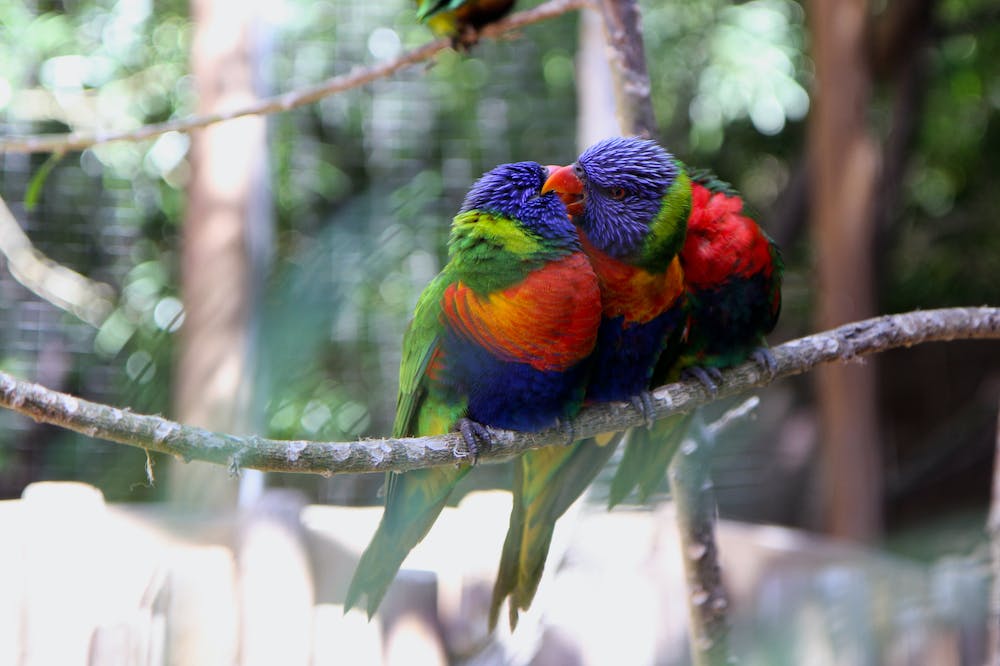
Lorikeets are brightly coloured birds of the Psittacine (parrot) family ranging from 15cm to 30cm in size, native to the Australasian region including south-eastern Asia, Papua New Guinea, and Australia. They are becoming increasingly more popular as pets, but general knowledge on their care is lacking or misleading. The most common lorikeets kept in Australia are the Rainbow Lorikeet and Scaly-Breasted Lorikeet; others include Red-Collared Lorikeet, Musk Lorikeet, Purple-Crowned Lorikeet and Little Lorikeet. Proper care for your lorikeet is important to help them live a long and happy life.
You should carefully consider whether a lorikeet is the right companion animal (pet) for you, for information on what to think about before making that decision, please see this article.
Housing
If your lorikeets are being kept as aviary birds, their enclosure should be long enough to allow the birds to fly. Alternatively, lorikeets may be kept in a large indoor cage, or housed outside during the day and brought inside overnight. Perches made of natural branches are best to prevent pressure sores and promote natural chewing behaviours. Dowel, metal, or plastic perches can cause sore feet and should not be used. Toys and other objects in the enclosure should not contain cotton or fine fibres (such as some rope toys) as these may cause a gut obstruction. All metal parts should be stainless steel, as other types can cause heavy metal poisoning. Lorikeets are messy birds and have naturally liquid droppings. Shredded newspaper is a good substrate for lining the cage floor and should be removed and replaced daily.
Outdoor enclosures should be strong and sturdy to protect against potential predators and the environment. Shelter should be provided with roofing, three protected sides, and hiding spots such as nesting boxes. Solid flooring is ideal as it is easy to clean and reduces transmission of parasites.
Cages should be placed away from the kitchen, fire, or any other source of smoke/gas/cooking area. For more information see our articles on where to keep birds and protect them from hazards.
Behaviour
Lorikeets are inquisitive, animated, and energetic birds. Adequate social interaction (both with people and other birds) and environmental enrichment are important to prevent boredom and associated behavioural and health problems. Lorikeets can live happily in a single-bird home with specialised care and daily socialisation with the rest of the (human) family.
Environmental enrichment is important to keep these energetic birds mentally stimulated. Lorikeets are naturally adapted to swinging and hanging upside down to retrieve nectar and therefore enjoy toys such as swings to mimic these behaviours. Leafy native Australian tree branches also provide good entertainment as well as perch sites. Toys and food can be used to encourage natural foraging behaviour.
Lorikeets are highly intelligent and easily trained. Training should be based on rewarding good behaviour and ignoring bad behaviour (never punish your lorikeet). Teaching your lorikeet to ‘step up’ and ‘step down’ can be very useful and provides great mental stimulation.
Diet
Lorikeets feed on pollen, nectar, and fruit; not seed. It is important to feed the correct diet, to prevent serious health problems. The way you feed your lorikeet can also provide them with hours of enrichment. The diet should include a high-quality commercial lorikeet mix, fruit, and native browse. There are both wet and dry commercial lorikeet feeds. These can even be made into ice cubes for a longer lasting summer snack. Lorikeets readily eat most fruits including apple, pear, grapes, melon, pawpaw, and orange. Fruit can also be frozen, wrapped in paper parcels or hung from the cage on skewers. Native browse is important for both nutrition and enrichment. Flowering cuttings from bottlebrush, eucalyptus, grevillea, and banksia plants should be given on a daily basis.
It is important your lorikeet maintains a healthy weight as obesity can lead to serious health problems such as diabetes. Ask your vet to check your lorikeet is in optimum condition. Good hygiene will also help minimise the risk of disease. Food should be replaced twice daily to prevent harmful bacteria from growing. Food should be placed up high in the cage to minimise contamination with faeces. Feed and water dishes should be washed daily in hot, soapy water.
Your lorikeet should also have a source of calcium – a small dish of shell grit, a cuttlebone, or a calcium bell should be left in the cage for your lorikeet to access as needed.
Health
Lorikeets can live for approximately 7-9 years. Your lorikeet should visit the vet at least once a year for a health check; this is the equivalent of us visiting the doctor once every 10 years! Birds are experts at hiding or ‘masking’ disease. Even if your lorikeet appears well, a physical exam by your veterinarian can identify health problems early on, and often results in a better outcome. Signs of sickness often only appear when the bird is very ill and incapable of ‘masking’. These birds appear fluffed up, eyes closed, lethargic or open-mouth breathing. If you notice any of these signs in your lorikeet, please contact your vet immediately.
Reference
Doneley B (2018) Avian Medicine and Surgery in Practice: Companion and Aviary Birds, 2nd ed. CRC Press
